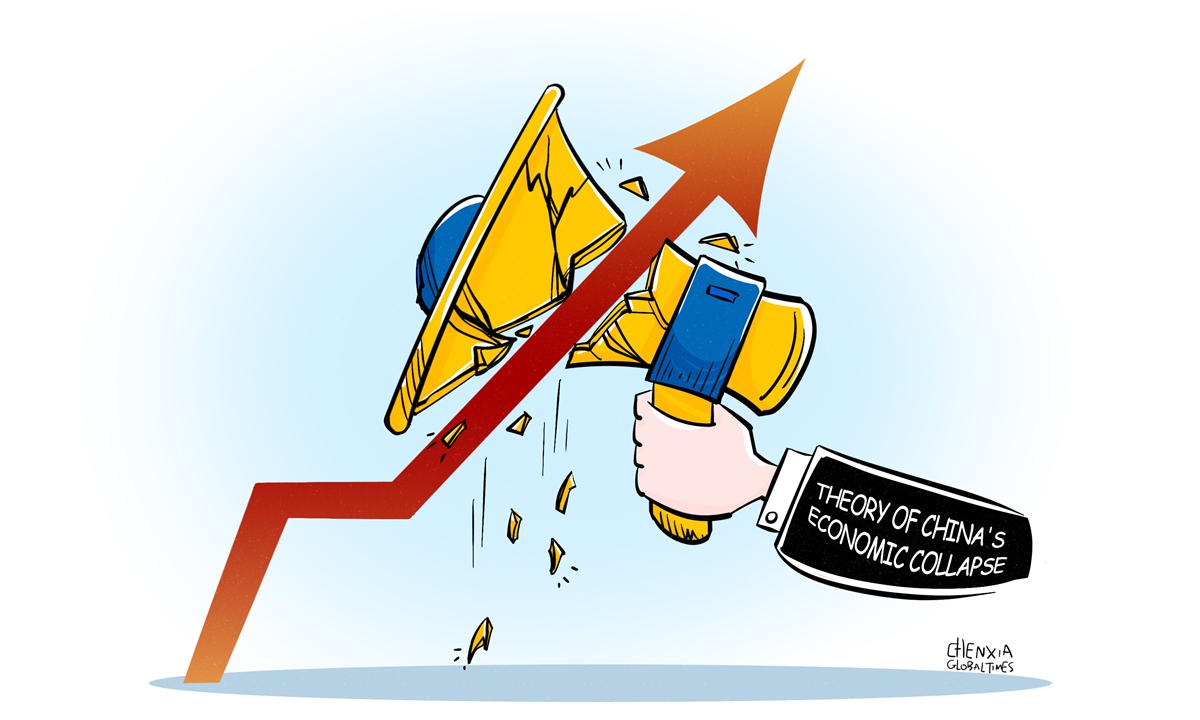China’s goal of doubling GDP in 2035 from 2020 isn’t out of reach

Illustration: Chen Xia/Global Times
China's central government has unveiled this year's GDP growth target, at about 5 percent, on par with last year's rate. The target has made market investors rejoice, giving them higher confidence in an across-the-board revival of China-related equities and other assets in the coming months. As expected, the country's A-share market has held on to strong gains in the past two weeks of robust trading.
But not all are elated with China's growth target. A good number of Western politicians and media pundits have claimed it is "too aggressive and lofty," a goal that may not be pulled off. Some of them are annoyed and disgruntled with China's resolve, and have started to curse the Chinese economy, predicting it will "capsize" and never close the current gap with the GDP of the US in nominal terms.
It's laughable and mean to diminish and denigrate others' economies. Last year, amid the Western media chorus of "China's economic collapse," the country's GDP expanded by 5.2 percent over a year earlier, with yearly added output value of more than 6 trillion yuan ($835 billion).
Compared with 2023, when China had just bid goodbye to the protracted and distressing three-year pandemic, there are better and riper conditions now to pursue a growth rate of about 5 percent in 2024. The lingering impact of the COVID-19 pandemic has been largely eliminated, and nearly all the fundamentals of the economy have been rehabilitated and shored up, which paves the way for a possible takeoff this year.
The central government is ready to fuel the economy in 2024 with a volley of growth-reinforcing stimulus policies, to be whipped up by a new mandate - brewing new quality productive forces to help build a stronger and greater country.
China is currently leading in the global endeavor in green and renewable energy, in electric vehicle and high-end battery development, in high-speed mobile telecom networks and railway roll-outs, in autonomous driving, deep space, modern robotics, artificial intelligence, quantum computing and other advanced sectors of information technology research and development. Naturally and consequentially, the country will be a front-runner in finding and creating new quality productive forces.
During a press conference held at the sidelines of the second session of the 14th National People's Congress recently, China's leading economic planners and policymakers discussed the magnitude of macro stimulus and overall policy direction for this year and beyond.
Collectively, officials displayed elevated confidence before global audiences that they are upbeat about realizing this year's growth targets, despite facing worldwide volatility including wars, conflicts, rising economic protectionism and technology isolation.
As to whether the GDP growth target of 5 percent is attainable, Zheng Shanjie, head of the National Development and Reform Commission, said it was set following the central government's comprehensive assessment, "taking into account current and long-term needs and possibilities" and the target is "a positive goal reachable with a jump," meaning through earnest hard work.
Lan Fo'an, the finance minister, and Pan Gongsheng, the governor of the People's Bank of China, the central bank, pledged more fiscal and monetary policy support to boost the economic revival. Commerce Minister Wang Wentao announced plans for a large-scale national trade-in event this year, aiming at replacing outdated manufacturing equipment, worn-out cars and home appliances to propel domestic consumption.
Wu Qing, head of the China Securities Regulatory Commission, vowed to significantly tighten capital market oversight to prevent irrational volatility.
Fiscally, China plans to issue an additional 3.9 trillion yuan in local government bonds in 2024 to support local government coffers, providing more financial resources for infrastructure construction and rural revitalization, including an initiative to dole out more welfare benefits to elderly rural residents.
The central government will issue ultra-long special treasury bonds starting this year and over each of the next several years to ramp up fiscal stimulus to support overall economic growth.
Monetarily, the central bank said it still has sufficient policy room in its toolbox. In contrast to other major economies, China isn't burdened by high inflation, which enables the central bank to maintain a lower interest rate policy and provide ample market liquidity. This will benefit Chinese business expansion, aid consumer spending and ratchet up overall economic activity in 2024.
Last month, the central bank reduced the benchmark five-year interest rate by 25 basis points. This move aims to ease the long-term burden on enterprises and is expected to significantly benefit the real estate sector, as the mortgage rates were lowered accordingly.
The economy has gotten off to a very strong start, as evidenced by steadily rising foreign trade. In the first two months, China's merchandise exports rose 10.3 percent year-on-year.
Meanwhile, the number of tourists who ventured out during the eight-day Chinese Lunar New Year holidays marked a staggering increase of 19 percent compared with the pre-pandemic number in 2019.
The upbeat figures show China's economic activity is rapidly gaining pace. With the government's enhanced fiscal and monetary stimulus, backed up by an improving stock market performance, the momentum for growth will accumulate and consistently build.
Provided China continues to focus on tech innovation, foster new quality productive forces and stick to the opening-up policy, typically helping its Belt and Road Initiative partners and the Global South to develop and prosper, the central government's development blueprint for 2035 - when GDP is to double from the 2020 level - isn't out of reach at all.
Photos
Related Stories
- China remains a powerhouse of global economy
- China moving to promote financial opening-up: central bank governor
- China's securities regulator to nurture sound capital market through supervision
- China's fiscal budget well implemented in 2023
- China's economic, social progress in 2023: Total Retail Sales of Consumer Goods Hit Historical High
- Deloitte China Chair: Put every business entity on a level playing field
Copyright © 2024 People's Daily Online. All Rights Reserved.









